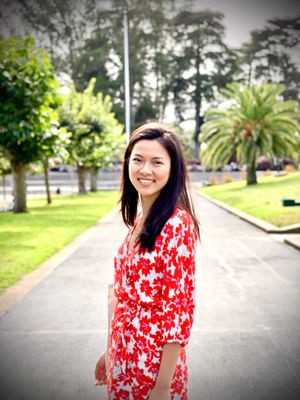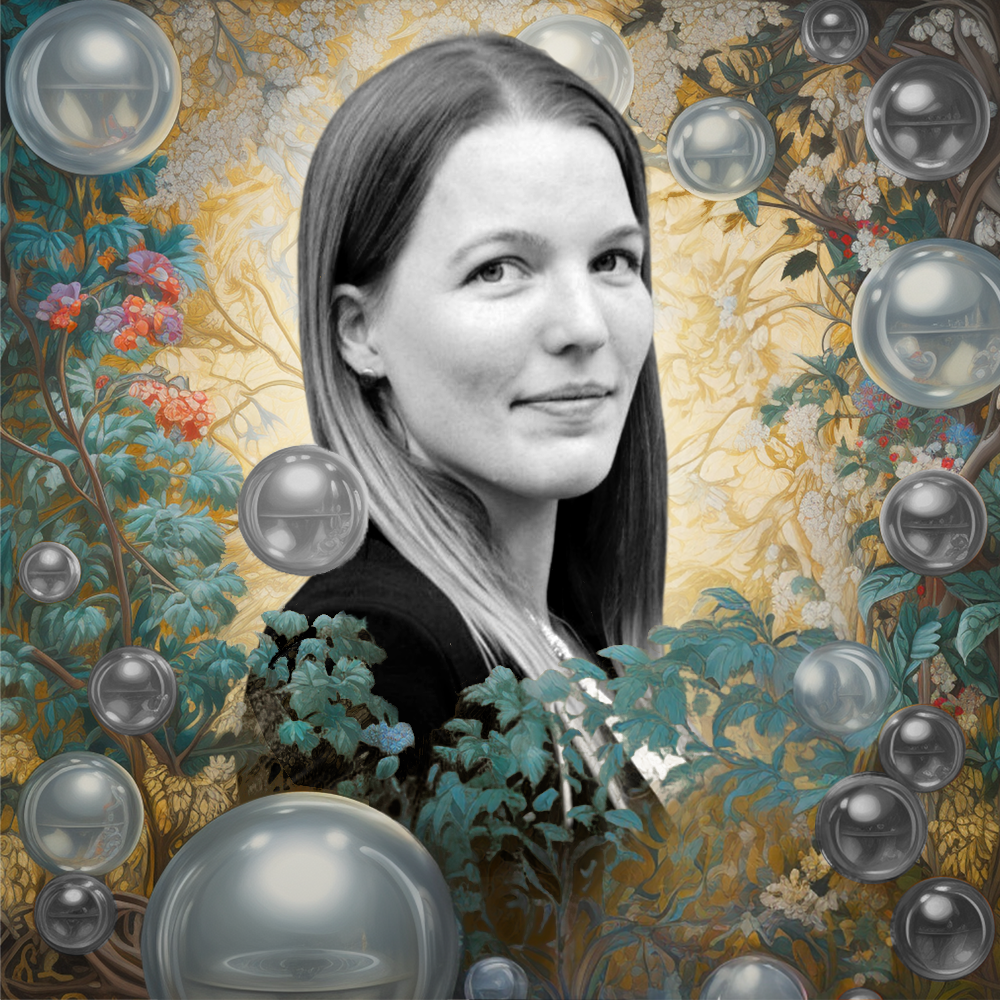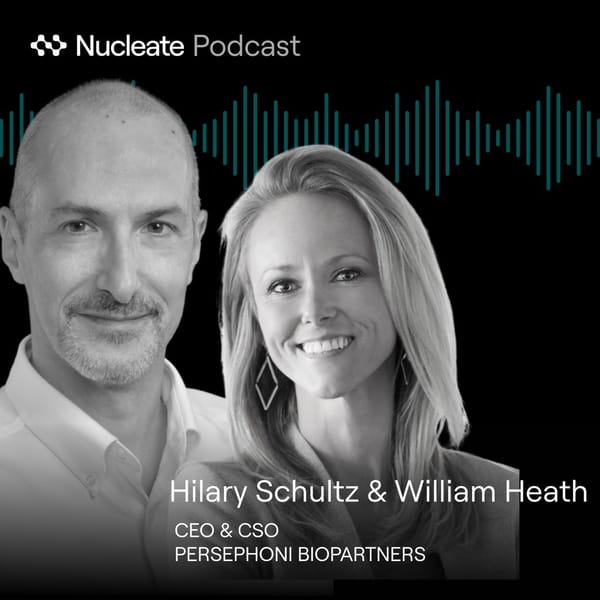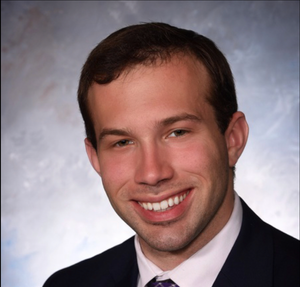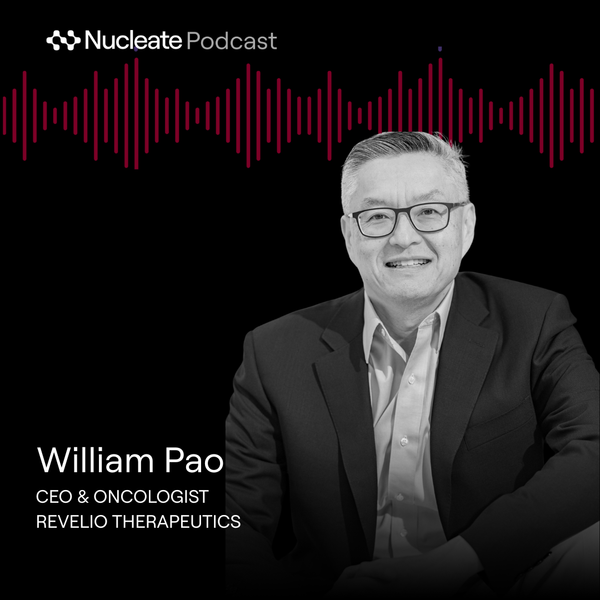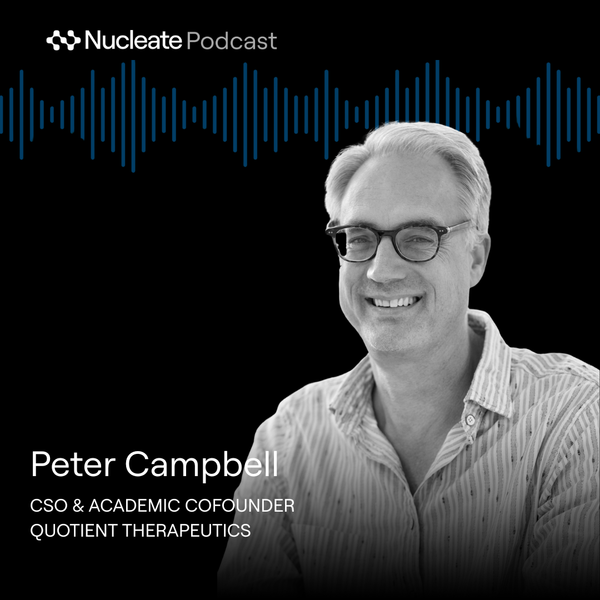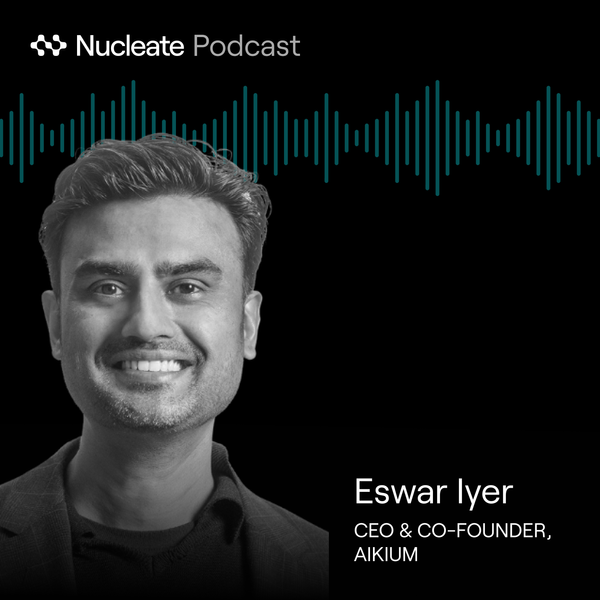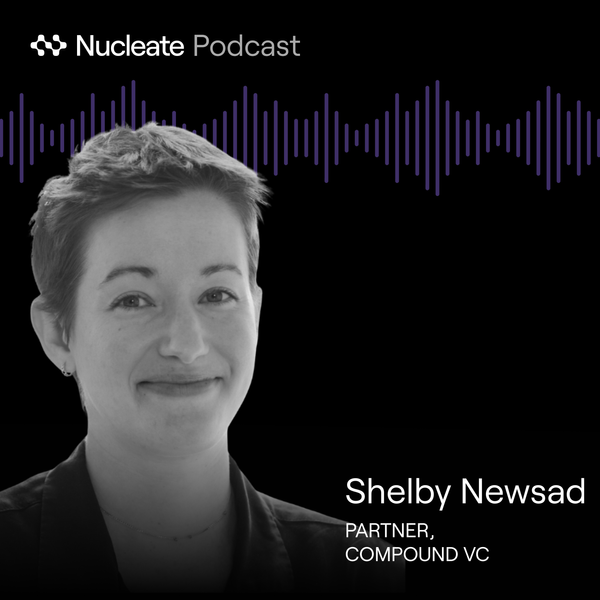| Hosts |
Emmanuella Nnuji-John
Jingyi Liu
|
| Editors |
Samantha Avina
Poonam Chitale
Emmanuella Nnuji-John
|
| Listen |
Signal welcomes Cheri Ackerman, co-founder of Concerto Biosciences. Cheri describes her journey from academia to starting a life sciences company. Concerto’s transformational technology, kChip, is changing the global outlook on the study of microbial interactions, with uses in medicine and agriculture. Cheri takes us on a ride to the world of scientific strategy as she delves into the myriad of opportunities that kChip creates and how this technology weaves into the company name, Concerto.
Show Notes
- How programs like Nucleate set the stage for the creation of Concerto and other biotechs [1:34]
- What Cheri’s postdoc-to-founder journey looked like [05:19]
- Advice for aspiring founders on successfully starting a company [10:32]
- What kChip is and how Concerto is prioritising this technology [22:10]
- Cheri’s favorite microbe and why [32:36]
Links
- More about Concerto Biosciences.
- More about Cheri’s background.
- A preprint describing the kChip technology.
Transcript
Ella: We're especially excited to talk to you today because Concerto’s origin story includes Nucleate (previously Activate). Young biotech enthusiasts have a ton of questions on how to get started with commercializing their scientific ideas. I was wondering, how did Nucleate or other related launch programs prepare you for life as a biotech founder and executive?
Cheri: They [Nucleate] were incredibly important, and I think it's really special to be here for the launch of Signal because Nucleate played such a critical role in Concerto’s own origin story. It's cool to be able to give our story back to the community and hopefully inspire other entrepreneurs in biotech. In terms of where we were when we started in nucleate - maybe two months before that, one of our co-founders had asked me, “Hey do you want to explore potentially commercializing kChip?” kChip is the name of the Platform technology that we had invented that ended up being the foundation of Concerto and I said sure. We had no idea what that was going to entail or how this might turn into a company. What we learned in Nucleate is two things: First thing was basic vocabulary. We didn't know terms like ‘Customer discovery’ or the what the concept of intellectual property entailed. What is a board of directors? What do they do?
We left Nucleate with a feeling for what we would be stepping into if we decided to do this for real.
The second thing was the network. We were matched with some really incredible mentors through the program and they continue to mentor us and advise Concerto to this day. They taught us the basics, opened up their network to us and let us talk to the people that were relevant to the problem we're trying to solve that they were already connected to. They helped us figure out how to do customer discovery, what a technology application matrix [is], and how you evaluate all the ways that your technology could apply the different applications.
Jingyi: I think a lot of other founders share the same sentiment. One is never quite ready to be a CEO. But [in] preparing to be a great CEO for Concerto, can you talk more about how you gathered leadership experiences from either lab or other experiences in your life? What advice could you give to people who are hoping to become the CEO of their company or another company? How can they build up their experience and leadership while they're still in school, are not quite sure in which direction to go?
Cheri: I think there are a few areas in which I would say I built up leadership expertise along the way. One of them is just scientific leadership. When you're in the lab and you're working with other graduate and undergraduate students, and having to shape a vision for where the project is going to go, identifying how each person is going to fit into that project and coordinating across maybe different labs or different skill sets is a very practical management skill set if you're going to start operating as a CEO. Ultimately, the way I became the CEO of Concerto was just stepping into that role. As our team was forming, we needed someone to be the person who was seeing the big picture. We needed someone coordinating with all the different people, and drawing on different people's skill sets and then being able to articulate Concerto’s vision to the outside world. So I drew on my experience of leading research teams to be able to lead the Concerto team which had obviously a different goal and is more commercial and impact driven but same sort of skill set.
I'd say another couple of areas were in my own volunteer work. I was involved in the chemistry graduate life committee at Berkeley and we worked on advocating for better relationships between faculty and researchers, especially in moments of conflict. What are the resources that are available to help those two people understand each other and come to a good resolution? How do we support graduate students through that those kinds of situations? My role in initiating that movement and shepherding that process in the department was I think very formative for me thinking about how people create change. That was a big part of me thinking Okay, what does it look like to create an organization that can actually make change? I also did a bunch of volunteering with the Church I was in at Berkeley as a deacon. That was very much I would say, emotional training. When people come to a church they're looking for much more than just the physical solution. They’re looking for spiritual connection and emotional connection, and so through that process I grew a lot in empathy and how you care for people who are in a space of real pain and frustration. It turns out that those skills are super helpful for being a CEO because there are all these moments where things don't go the way that you wish that they would go and having that emotional presence and ability to see that people are whole people I think has been important in my role.
Ella: Tell us a little bit about the name Concerto. What inspired this name, how does it reflect the work that you guys do?
Cheri: It took us so many hours to come up with the name and we're so proud of it. A Concerto is a piece of music in which an orchestra supports central instruments. You can have a violin concerto in which there is a central violinist that is performing and the orchestra comes around that violinist to create an incredible piece of music that highlights what that violinist can do, or you can have a piano concerto etc. What we do as a company is build groups of microbes that work together to support some central function or key microbe in that we're trying to get that group of microbes to do together. We love the way that this name reflects the science that we're trying to accomplish in the world. A number of people in the company, including our Chief Scientific Officer, are musicians. Music is just near and dear to many of our hearts and so it's fun to have a name that reflects that part of who we are as people.
Ella: Your company uses a platform called kChip to measure- microbial interactions that influence a behavior of interest. In general terms for a non-scientific audience, can you tell us about this technology?
Cheri: The main issue in science that kChip overcomes is getting experimental data on groups of microbes. Most of the microbiome industry today operates on two main types of data. The first is microbial isolates. You can take a complex mixture of microbes, pull one microbe out of that mixture, and then put it in a petri dish and study it on its own. That's very traditional microbiology. The other type of data is next generation sequencing. This is sequencing DNA in samples, and you can make a list of all the microbes that are in healthy people and in people with some diseases and compare those lists to correlate microbes to health or disease. Those data sets have been incredibly important for showing us that microbes are important in human health. What those data sets don't tell us, is how these microbes are interacting and how those interactions give rise to the larger community level behaviors that drive microbiome function. That's really what's important in human health is how those microbiomes are functioning as a whole. Microbes in real life don't live in isolation and they're in these complex ecosystems that are always interacting. The problem is that experimentally, if you have a library of 1000 microbes and want to measure every possible pair from within that thousand. That is half a million measurements that you would have to make. And if you make those communities even slightly larger, so to say, sets of three explode into billions of interactions that you would have to measure. And all the existing technologies today, even the fastest robots can only do about 20,000 interactions per day. When you do the math you very rapidly realize that there's no way that we can use existing technology to experimentally explore this huge common editorial space. We invented kChip as a way of getting this experimental data for the first time to be able to measure millions of combinations of microbes and create these interaction network maps.
Physically, there are two main principles that allow kChip to operate. One is miniaturization, so all of the microbial cultures that we use on kitchen or in nano leader droplets. This means that we can manipulate hundreds of thousands of them in parallel. The second is randomization, and this is pretty different from a robot. With a robot, you'll tell it: I want you to put microbe #1 and microbe #2, now I want you to put back on #1 and #3. Then the robot goes along deterministically loading all of the different wells of the chip – which can take a long time. In kChip the droplets flow randomly over an array of micro wells. And because they're loading randomly, they're loading all at the exact same time in parallel, and we can load 100,000 wells in about five minutes. This is huge-throughput compared to what you could do with robotics. Last summer we spent a couple of weeks just doing full time screening in the lab and collected like 5 million data points in two weeks. That's the largest dataset on microbial interactions that anyone has ever had. It's super cool then to have this dataset that unlocks a new understanding of how the microbiome works and allows us to see new products that no one has ever been able to identify before, because we can see the microbiome that way.
Ella: In the spirit of intersection and collaborative science, Concerto is providing solutions to both treat diseases and improve crop yield so you guys are bridging the gap between two very big global problems. In fact, the very first Concerto product is a community of microbes that is restoring the microbiome of the skin and treating eczema. At any given moment, how do you prioritize which products to which to direct Concerto's resources?
At the very beginning, nobody believed that we could even run this platform.
Cheri: Yeah that's a really good question. I would say, for anybody that is working on a platform technology this is literally the billion-dollar question. What are you going to apply that technology to? Because if you start in the right place, you can very rapidly scale to other things. If you start in a place that is too hard, [you] faceplant. If you start in a place that's too easy then you're not interesting to investors. Finding that goldilocks application that is both technically super tractable and financially attractive to the investment community [in an] impactful way that will benefit [a lot] of people [is] the billion-dollar question. For us, there were two things that were driving our selection. One is the technology application matrix I mentioned earlier. The way that this works is you take all the attributes of your technology and you wind them up on one axis of the matrix. For us it's things like: can you build a biobank of microbes from the natural environment? Where you would expect this product to work? Is it easy to do that? For example, is it easy to make an asset that will work in kChip? You wind up all of those things on one axis, and those are things including market size and competitive landscape. On the other axis you put all of the different applications you could imagine working in and try to create a scorecard for each of those applications across all of the different technical and market aspects that you think are relevant.
Ultimately you end up with a ranking, and this is a super hand-wavy welcome to the business world of the things that you think are going to be a better fit or worse fit for where you are right now. One of the major drivers was that we didn't really want to get into the anaerobic microbiome too soon. Working on things where oxygen will kill the microbes is a very technically difficult space. So we were looking at the aerobic microbes as a low hanging fruit. We thought the need in atopic dermatitis or eczema is just huge. A couple of our co-founders have eczema, so we have personal motivation there. When we looked at that technology matrix it just made a lot of sense combining that unmet need and technical fit and market size and interest from investors, etc. That was one thing that we’re thinking a lot about when we selected X amount, in particular. In general, how you focus a platform company at any point in its life cycle has a lot to do with where you think the key risks are for the platform. At the very beginning, nobody believed that we could even run this platform.
No one believed we could have an idea of what these microbes were going to do and build a biobank, build the assays, use kChip and […] pop [out] a group of microbes that would do the thing that we said it was going to do. From the very beginning, we needed to prove that we can run that process. In the beginning our pre seed funding was just enough money to run that process once and prove that we could do it and we risked that aspect of the company. That was an awesome value inflection point for us to be able to say […] we can run the platform once. Then the question, the risks are different. At this point for our company, the risks are twofold. One is this group of microbes that we found using kChip. They perform the way that we say that they'll perform in vitro, but will they keep that function when we move it onto the surface of human skin? Will it translate from this in vitro contract context to an in vivo context? That is something that we're actively de-risking right now. The other is demonstrating the versatility of the platform. We have used this platform in skin once [and] it worked very well. Now, what nobody believes is that we can use it in agriculture and women's health and all of these other areas that are super interesting to pursue. Another thing we're de-risking right now [are those] applications in agriculture and women's health to show that this is not a one hit wonder situation. This is a true platform that will work across many different areas. In addition to doing that technology matrix of trying to figure out where the best fit of technology and market is, you also need to think about what investors [are] most worried about. Where you think your largest risks are and can you show that it's not a risk. We can accomplish that task, or that challenge.
Jingyi: On the subject of risk, I was wondering if you could tell us a little bit more about the conversations with regulatory authorities? If there are any conversations around the concept of microbial communities? One of the advantages of doing something so innovative and one of the risks, is that no one has really done what you're doing before. Right? I mean we have microbiome therapeutics that are in various stages of development. I believe fecal transplant is approved for C. difficile, but it's a little bit different from what you're doing. How do you approach conversations about regulatory risk? How do you think about the regulation of microbial community therapeutics, and also other applications as you're going forward With Concerto?
Cheri: Yeah that's a good question. We benefit a lot from being what we would call a “fast follower” in this space. We are not the first company to start, to go out on a limb and say we're going to try to make bugs into drugs. We're going to try to make what the FDA calls “alive by the therapeutic product”. There are companies that have been working in this space for almost a decade at this point. The Federal Drug Administration (FDA) is not totally unfamiliar with this modality. You can look up there's a guidance, that the FDA published on. chemistry manufacturing and control CMC in live by the therapeutic products lps. So if you think that biotech has its own set of jargon and acronyms, try working in the FDA and biotech, you will get an entirely different level of jargon. Reading those has been hugely helpful to us. We are indebted to the companies that have gone before [us] and have worked with the FDA to start to define these parameters. What no one has yet succeeded at doing is making a defined group of microbes that passes all the FDA safety and efficacy checks. Getting through phase three and actually getting a drug approved out of a defined microbe, a lot of that [is] the industry [just] hasn't been around long enough. I think the front runners right now are in, going into, or completing phase three trials. That’s not because they've been slow. They haven't been slow, they have been average pace of drug development. It's just a really long process to get something through FDA approval. In terms of how we have been navigating that, I think there are a couple of things to think about. One is safety. The cool thing about working with microbes that have not been edited that just come from healthy human skin or healthy, you know, a healthy human mouth, or something like that is these microbes are already considered to be safe by the FDA.
You have to do some basic test work and make sure that, for example, the microbes don't carry any antimicrobial resistance genes. If something was to go wrong, and you needed to get rid of all these microbes on the skin, can we just apply an over the counter. Or not over the counter but like off the shelf antibiotic and get rid of it then it's not a big deal anymore. And the answer is yes, for these microbes. Which is really nice and the FDA looks at that and says yeah that's pretty safe. The other aspect is efficacy, and this bar is very disease specific. So you just need to understand for us it's on what are the end points that the FDA considers meaningful in a topic dermatitis. There are scales that the FDA has accepted for scoring how bad a topic dermatitis is, and you have to achieve certain improvement levels on that scale and that's what the FDA is looking for. And that is true! If you are a steroid that's true, if you're an injectable that's true, [or] if you're alive by a therapeutic product. That is just an advocacy standard that everybody has to meet. Understanding what things are specific to lb PS as a modality versus what things are just standards in the field that you have to achieve, is a big part of working with the FDA. Also[ to] say that it is not something that anyone should approach alone. If you are a young founder and you've never done this before navigating the FDA, navigating regulatory, is something where you should be bringing in outside expertise and getting people who have done this before. It's really not something you want to screw up. You don't want to end up on clinical hold. That can be deadly to a tiny company.
Jingyi: Amazing! Well, I think everyone can say that you're doing an amazing job and I’m sure you will continue to be ahead of the learning curve, for a long time. Especially with that attitude. It has so much to do with it as well and creating a culture of learning for the rest of your team. We're really excited to see what comes up next for Concerto as you embark on the next parts of your journey as a company. As a Nucleate alumnus, do you have any advice for people who are in a similar stage as you were a couple of years ago regarding their company or their technology. How do you embark on the next steps of your entrepreneurial journey as part of Nucleate?
The world is going to tell you no, over and over and over again. It's going to put up plenty of walls for you. So don't you tell yourself no.
Cheri: First, this is a piece of advice that I give very liberally so if you've heard me speak in other places, you might have heard me say it. Which is: don't tell yourself no. The world is going to tell you no, over and over and over again. It's going to put up plenty of walls for you, so don't you tell yourself no. You go for it and see what you can make happen in the world if you believe that you have what it takes and believe that you are passionate about seeing something happened in the world go. Try to make it happen. There's no reason to try to talk yourself out of it.
The second thing I think, is something that has become like more and more important to me as I’ve matured in this role. Invest in your own emotional skills. This is something that I cared about for a long time and I’m still getting better at it. This is just super important for making connections with other people trying to understand what motivates [them] and what does each individual need out of the different conversations. Whether this is a potential partner, a potential investor, an employee, or your co-founder. Being able to see that people don't make decisions based on logic, we say that we do, but we really don't, we make decisions based on how we feel. We use logic to back those things up later, and it is rare to find a person that's making a decision just based on logic. Having the ability to modulate your own emotions and care for yourself as you're going through the roller coaster of founding a company, having the ability to care for your team, and connect with investors and partners is just incredibly important. I think, from a practical perspective, that means getting yourself coaching or counseling. As you're walking through the hard stuff, that is part of founding a company and building your own skill set. [For example], reading and going to trainings and investing in your own ability to be there for yourself and for your team . In terms of who to go on the entrepreneurial journey with, other people who you trust. For me, that [has] a lot to do with connection at a gut level. [Moreso, about] being able to understand what motivates this person, and how we [are] going to align and keep ourselves alive as we're going through some of the hardest parts of our lives and coming years.
Jingyi Liu: I think that's an interesting point Cheri, about understanding people's motivations, where they're coming from, and what they're inspired by. Great so we have some fun rapid closing rapid fire closing questions that we wanted to ask you.
Ella: Cheri, what is your favorite microbe, and why?
Cheri Ackerman: You should ask our Chief Scientific Officer this question, I work in business now. I think, then, my favorite microbe is a microbe that we affectionately call microbe. I can't tell you what it is, but it's super powerful in the system that we're working on, and therefore it is kind of my favorite.
Ella: Very cool. What other biotech inventions are you excited by besides microbial communities?
Cheri: I think anybody who is pushing the boundaries on what data can possibly be collected in the world. People who work on things like protein sequencing or seeing biology in a way that we haven't been able to see before. I think if I weren't working on this, I think I'd be working on another emerging field: spatial -omics and understanding how tissues or ecosystems are organized.
I also think women's health is another area that is just incredibly underserved right now. Eendometriosis is an area that I would be working on, if I wasn't working on what I’m doing now. I wish I could point to a specific invention and say like this is a really cool thing that's going to solve the problem, but we're way earlier than that just trying to understand what is going on […]. Seeing expansion into those areas that have been so underserved is really exciting to me.
Ella: Thank you for coming on the podcast Cheri.
Cheri: My pleasure.


